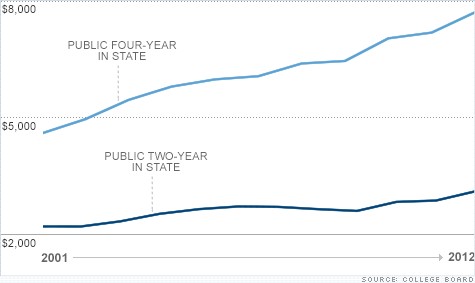On the eve of implementing the Department of Education’s (ED) highly controversial Gainful Employment regulations, the United States District Court for the District of Columbia ruled against the Department of Education and struck down the regulations, stating that, “The debt repayment standard was not based upon any facts at all.”
While many in Higher Education celebrated the ruling, the uncertainty of how the Department of Education would respond meant that most schools continued to prepare for the reintroduction of some form of Gainful Employment regulations. This turns out to have been a smart move, because on July 30
th of this year, the ED went back to court to seek reinstatement of some of the requirements of the rule.
With the rising national debt, it’s not likely that Congress will lessen its focus on the costs of Higher Education. In fact, over the last decade,
tuition costs have risen nearly 70%, and are up 429% in the last two decades! With those cost increases, student debt and loan default rates are also on the rise. The average student debt is $27,000. When you couple that with the fact that 50% of students seeking a Bachelor’s Degree and only 21% of students seeking an Associate’s Degree actually attain them, you can quickly see the repayment challenges students are facing.
Accreditation Bodies Feeling the Heat
Schools have been questioned on their commitment to prepare students for jobs that will provide their students the ability to secure employment at salaries that will allow them to meet their financial obligations. Those questions were often answered by obtaining the appropriate accreditation. That is no longer the case.
Institutions of higher learning are not the only ones feeling the heat. Accrediting bodies are also under scrutiny. Congress and the ED have taken a hard look at some of the practices and policies of both National and Regional accreditors. They are reviewing the Standards of Accreditation for each, and in some cases, challenging decisions on school accreditation.

And the accrediting bodies are taking government concerns seriously. Under the threat of stripping their authority to make accrediting decisions, accreditors have taken steps to increase graduation and placement rates, while lowering loan default rates.
What Can You Do?
In preparing to meet the expected implementation of Gainful Employment regulations, schools and accreditors have taken steps to review and improve policies and practices in all areas. Schools are:
- Developing new admission policies aimed at identifying an applicant’s abilities and risk factors that can impact their ability to succeed.
- Focusing on measuring student engagement and the factors that influence it.
- Meeting with employers to understand the skills graduates need to secure employment.
- Measuring learning outcomes throughout the program to ensure needed skills are mastered.
- Driving change in their Student Services departments to increase placement rates and secure gainful employment for all students.
Despite the challenges surrounding the implementation of these initiatives, schools should embrace them as a means to provide students better opportunities to position themselves for gainful employment.
The goal of every graduate finding a job is nothing new. Schools have been doing that for generations. What
is new is that they now have new – and better - tools with which to accomplish those goals.
 And the accrediting bodies are taking government concerns seriously. Under the threat of stripping their authority to make accrediting decisions, accreditors have taken steps to increase graduation and placement rates, while lowering loan default rates.
What Can You Do?
In preparing to meet the expected implementation of Gainful Employment regulations, schools and accreditors have taken steps to review and improve policies and practices in all areas. Schools are:
And the accrediting bodies are taking government concerns seriously. Under the threat of stripping their authority to make accrediting decisions, accreditors have taken steps to increase graduation and placement rates, while lowering loan default rates.
What Can You Do?
In preparing to meet the expected implementation of Gainful Employment regulations, schools and accreditors have taken steps to review and improve policies and practices in all areas. Schools are:


